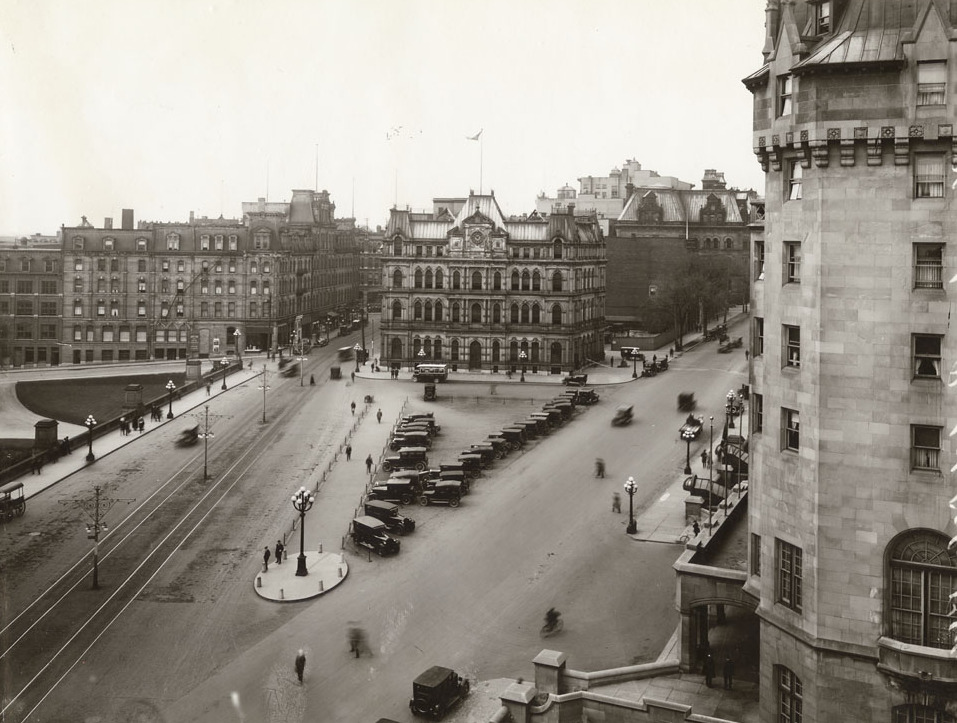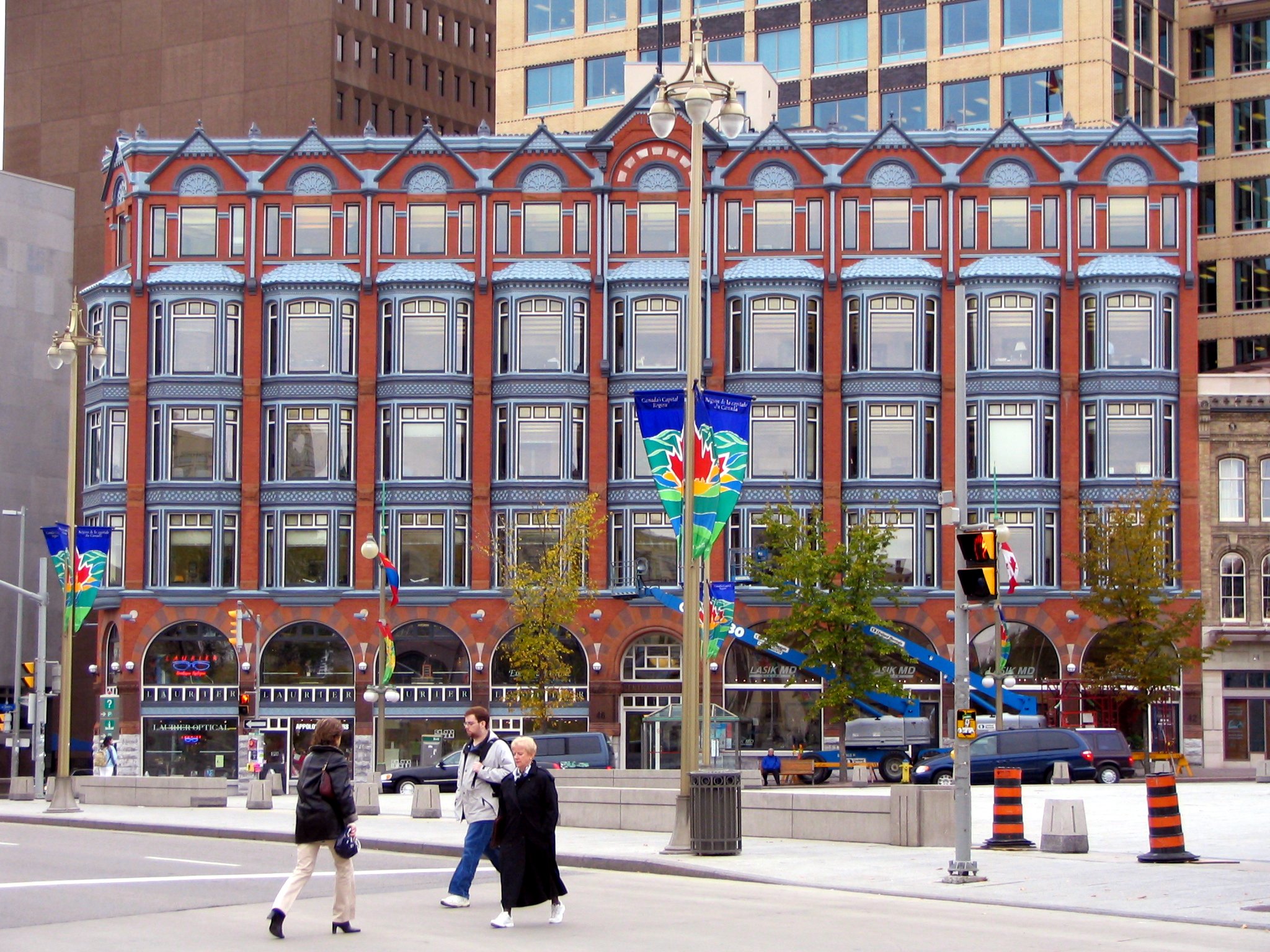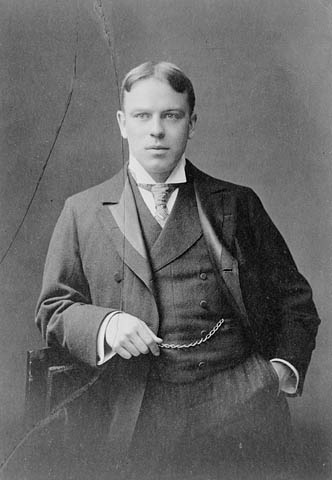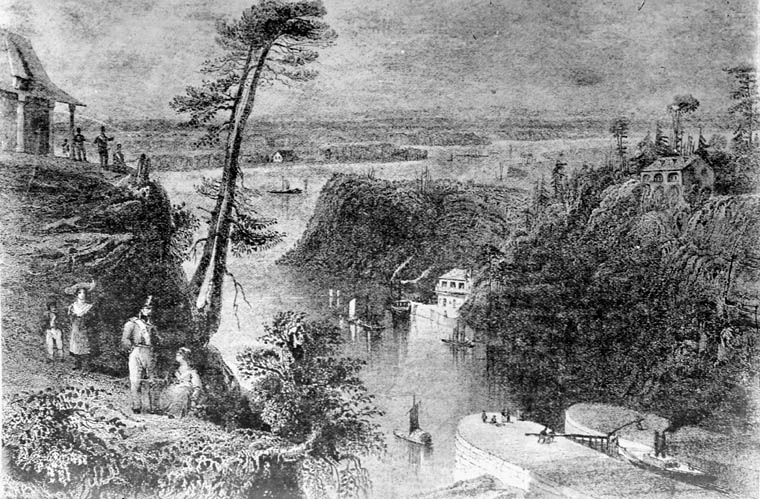|
Confederation Square
Confederation Square (french: Place de la Confédération) is an urban square in Ottawa, Ontario, Canada, and is considered the second most important ceremonial centre in Canada's capital city, after Parliament Hill. Roughly triangular in area, with Canada's National War Memorial at its centre and the Valiants Memorial at its periphery, the square is bounded by Wellington Street to the north and branches of Elgin Street to the east and west. The square was designated a National Historic Site of Canada in 1984. Confederation Square's importance is due not only to its central location in Ottawa and its status as a rare Canadian example of a City Beautiful-inspired square, but also arises from the landmark buildings that frame the square: the Château Laurier, the Senate of Canada Building, the National Arts Centre, the Central Chambers, the Scottish Ontario Chambers, the Central Post Office, the PMO and the East Block. Part of the square crosses over the Rideau Canal, it ... [...More Info...] [...Related Items...] OR: [Wikipedia] [Google] [Baidu] |
Canadian French
Canadian French (french: français canadien) is the French language as it is spoken in Canada. It includes multiple varieties, the most prominent of which is Québécois (Quebec French). Formerly ''Canadian French'' referred solely to Quebec French and the closely related varieties of Ontario ( Franco-Ontarian) and Western Canada—in contrast with Acadian French, which is spoken by Acadians in New Brunswick (including the Chiac dialect) and some areas of Nova Scotia (including the dialect St. Marys Bay French), Prince Edward Island and Newfoundland & Labrador (where Newfoundland French is also spoken). In 2011, the total number of native French speakers in Canada was around 7.3 million (22% of the entire population), while another 2 million spoke it as a second language. At the federal level, it has official status alongside Canadian English. At the provincial level, French is the sole official language of Quebec as well as one of two official languages of New Brunsw ... [...More Info...] [...Related Items...] OR: [Wikipedia] [Google] [Baidu] |
Central Chambers (Ottawa)
Central Chambers is a building at the corner of Elgin Street and Queen Street in Ottawa that is a National Historic Site. It is located at 42 to 54 Elgin Street, next to Bell Block. It faces the Canadian War Memorial at Confederation Square. Central Chambers was built between 1890 and 1893 and designed by John James Browne of Montreal, an example of Queen Anne Revival commercial architecture. Formerly serving as an office for the Canadian Atlantic Railway, it now houses the National Capital Commission. The building was purchased by the NCC in the 60's, remained vacant throughout much of the 70s and 80s, and in 1992, plans were made for renovations. In 1994 the NCC gutted the interior and the facade became integrated into a new office tower complex. It was designated as a National Historic Site of Canada in 1990 for being a fine example of the Queen Anne Revival style in commercial architecture. Central Chambers Buildings May 1893.jpg, Central Chambers, 1893 Central Chamb ... [...More Info...] [...Related Items...] OR: [Wikipedia] [Google] [Baidu] |
William Lyon Mackenzie King
William Lyon Mackenzie King (December 17, 1874 – July 22, 1950) was a Canadian statesman and politician who served as the tenth prime minister of Canada for three non-consecutive terms from 1921 to 1926, 1926 to 1930, and 1935 to 1948. A Liberal, he was the dominant politician in Canada from the early 1920s to the late 1940s. King is best known for his leadership of Canada throughout the Great Depression and the Second World War. He played a major role in laying the foundations of the Canadian welfare state and established Canada's international reputation as a middle power fully committed to world order. With a total of 21 years and 154 days in office, he remains the longest-serving prime minister in Canadian history. Born in Berlin, Ontario (now Kitchener), King studied law and political economy in the 1890s and became concerned with issues of social welfare. He later obtained a PhD – the only Canadian prime minister to have done so. In 1900, he became deputy ministe ... [...More Info...] [...Related Items...] OR: [Wikipedia] [Google] [Baidu] |
Wilfrid Laurier
Sir Henri Charles Wilfrid Laurier, ( ; ; November 20, 1841 – February 17, 1919) was a Canadian lawyer, statesman, and politician who served as the seventh prime minister of Canada from 1896 to 1911. The first French Canadian prime minister, his 15-year tenure remains the longest unbroken term of office among Canadian prime ministers and his nearly 45 years of service in the House of Commons is a record for the House. Laurier is best known for his compromises between English and French Canada. Laurier studied law at McGill University and practised as a lawyer before being elected to the Legislative Assembly of Quebec in 1871. He was then elected as a member of Parliament (MP) in the 1874 federal election. As an MP, Laurier gained a large personal following among French Canadians and the Québécois. He also came to be known as a great orator. After serving as minister of inland revenue under Prime Minister Alexander Mackenzie from 1877 to 1878, Laurier became leader ... [...More Info...] [...Related Items...] OR: [Wikipedia] [Google] [Baidu] |
Union Station (Ottawa)
The Senate of Canada Building (french: édifice du Sénat du Canada) is located at 2 Rideau Street in downtown Ottawa, Ontario, Canada and serves as the temporary seat of the Senate of Canada. The building served as Ottawa's central railway station (Ottawa Union Station) from 1912 until 1966, and from 1966 to 2018 it was operated by the Government of Canada as the Government Conference Centre. The building currently includes a temporary Senate chamber, as well as some Senate offices and committee rooms. It is situated at the intersection of Wellington Street and the Rideau Canal, across the street from the Château Laurier hotel (which was constructed around the same time). It is from Parliament Hill and Confederation Square. History History of Railways in Ottawa Before the turn of the twentieth century, several railway companies had run lines into the city and had begun to build railway stations. In chronological order: #New Edinburgh: Bytown and Prescott Railway #B ... [...More Info...] [...Related Items...] OR: [Wikipedia] [Google] [Baidu] |
Plaza Bridge (Ottawa)
The Plaza Bridge in Ottawa, Ontario, Canada, is an automotive and pedestrian bridge that crosses the Rideau Canal just south of the Ottawa locks. It joins Wellington Street and Elgin Street in the Downtown core to the west with Rideau Street to the east. The Chateau Laurier abuts the bridge at the east end, while Parliament Hill is just beyond the west end. It is the northernmost bridge over the canal, just north of the Mackenzie King Bridge. The bridge is constructed of three masonry spans. The western span is over a roadway along the western bank of the Canal. The central span is over the Canal. The eastern span is over a former railway tunnel running along the east bank of the Canal. History Sappers' Bridge Sappers Bridge was one of Ottawa's first bridges (Bytown at the time), built in 1827 over the Rideau Canal connecting Rideau Street in Lower Town with Upper Town. The bridge got its name from the builders, the Royal Sappers and Miners.. It was demolished in ... [...More Info...] [...Related Items...] OR: [Wikipedia] [Google] [Baidu] |
Prince Arthur, Duke Of Connaught And Strathearn
Prince Arthur, Duke of Connaught and Strathearn (Arthur William Patrick Albert; 1 May 185016 January 1942), was the seventh child and third son of Queen Victoria of the United Kingdom and Prince Albert of Saxe-Coburg and Gotha. He served as Governor General of Canada, the tenth since Canadian Confederation and the only British prince to do so to date. Arthur was educated by private tutors before entering the Royal Military Academy at Woolwich at 16 years old. Upon graduation, he was commissioned as a lieutenant in the British Army, where he served for some 40 years, seeing service in various parts of the British Empire. During this time he was also created a royal duke, becoming Duke of Connaught and Strathearn as well as Earl of Sussex. In 1900 he was appointed as Commander in Chief of the British Army in Ireland, which he regretted; his preference being to join the campaign against the Boers in South Africa. In 1911, he was appointed as Governor General of Canada, replac ... [...More Info...] [...Related Items...] OR: [Wikipedia] [Google] [Baidu] |
Ottawa Old Post Office Confederation Square
Ottawa (, ; Canadian French: ) is the capital city of Canada. It is located at the confluence of the Ottawa River and the Rideau River in the southern portion of the province of Ontario. Ottawa borders Gatineau, Quebec, and forms the core of the Ottawa–Gatineau census metropolitan area (CMA) and the National Capital Region (NCR). Ottawa had a city population of 1,017,449 and a metropolitan population of 1,488,307, making it the fourth-largest city and fourth-largest metropolitan area in Canada. Ottawa is the political centre of Canada and headquarters to the federal government. The city houses numerous foreign embassies, key buildings, organizations, and institutions of Canada's government, including the Parliament of Canada, the Supreme Court, the residence of Canada's viceroy, and Office of the Prime Minister. Founded in 1826 as Bytown, and incorporated as Ottawa in 1855, its original boundaries were expanded through numerous annexations and were ultimately ... [...More Info...] [...Related Items...] OR: [Wikipedia] [Google] [Baidu] |
World Heritage Site
A World Heritage Site is a landmark or area with legal protection by an international convention administered by the United Nations Educational, Scientific and Cultural Organization (UNESCO). World Heritage Sites are designated by UNESCO for having cultural, historical, scientific or other form of significance. The sites are judged to contain " cultural and natural heritage around the world considered to be of outstanding value to humanity". To be selected, a World Heritage Site must be a somehow unique landmark which is geographically and historically identifiable and has special cultural or physical significance. For example, World Heritage Sites might be ancient ruins or historical structures, buildings, cities, deserts, forests, islands, lakes, monuments, mountains, or wilderness areas. A World Heritage Site may signify a remarkable accomplishment of humanity, and serve as evidence of our intellectual history on the planet, or it might be a place of great natural beauty. A ... [...More Info...] [...Related Items...] OR: [Wikipedia] [Google] [Baidu] |
Rideau Canal
The Rideau Canal, also known unofficially as the Rideau Waterway, connects Canada's capital city of Ottawa, Ontario, to Lake Ontario and the Saint Lawrence River at Kingston. It is 202 kilometres long. The name ''Rideau'', French for "curtain", is derived from the curtain-like appearance of the Rideau River's twin waterfalls where they join the Ottawa River. The canal system uses sections of two rivers, the Rideau and the Cataraqui, as well as several lakes. Parks Canada operates the Rideau Canal. The canal was opened in 1832 as a precaution in case of war with the United States. It remains in use today primarily for pleasure boating, with most of its original structures intact. The locks on the system open for navigation in mid-May and close in mid-October. It is the oldest continuously operated canal system in North America. In 2007 it was registered as a UNESCO World Heritage Site. History Plan After the War of 1812, information was received about the United States ... [...More Info...] [...Related Items...] OR: [Wikipedia] [Google] [Baidu] |
East Block
The East Block (officially the Eastern Departmental Building; french: Édifice administratif de l'est) is one of the three buildings on Canada's Parliament Hill, in Ottawa, Ontario, containing offices for parliamentarians, as well as some preserved pre-Confederation spaces. Built in the Victorian High Gothic style, the East Block is, along with the Library of Parliament, one of only two buildings on Parliament Hill to have survived mostly intact since original construction. Though not as renowned as the Centre Block of parliament, the East Block formerly appeared on the face of the Journey Series design of the Canadian hundred-dollar bill. The East Block is open to the public for tours in July and August. Characteristics Designed by Thomas Stent and Augustus Laver, the East Block is an asymmetrical structure built in the Victorian High Gothic style, with load bearing masonry walls being nearly 0.9 m (3 ft) thick at the ground level, expanding to 2.1 m (7 ... [...More Info...] [...Related Items...] OR: [Wikipedia] [Google] [Baidu] |







